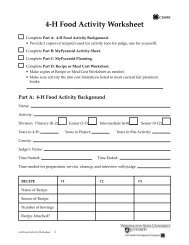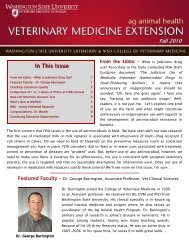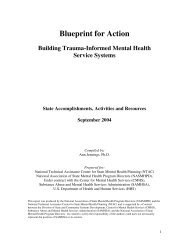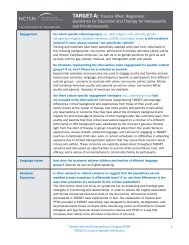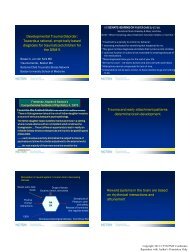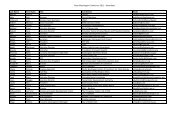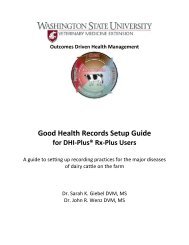Calving Time Management for Beef Cows and ... - OSU Fact Sheets
Calving Time Management for Beef Cows and ... - OSU Fact Sheets
Calving Time Management for Beef Cows and ... - OSU Fact Sheets
- No tags were found...
You also want an ePaper? Increase the reach of your titles
YUMPU automatically turns print PDFs into web optimized ePapers that Google loves.
<strong>and</strong> post copies in convenient places. Talk to the localveterinarian about the protocol <strong>and</strong> incorporate his/her suggestions. Your veterinarian will be a lot morehelpful when you have an emergency during thekids’ school program if you have talked a few timesduring regular hours.• Lubrication: Many lubricants have been used <strong>and</strong>one of the best lubricants is probably the simplest –non-detergent soap <strong>and</strong> warm water.• Supplies: The stockman should always have in hismedicine chest the following: disposable obstetricalsleeves, non-irritant antiseptic, lubricant, obstetricalchains (60 inch <strong>and</strong>/or two 30 inch chains), twoobstetrical h<strong>and</strong>les, mechanical calf pullers, <strong>and</strong>injectable antibiotics. Do not <strong>for</strong>get the simple thingslike a good flashlight with extra batteries <strong>and</strong> someold towels or a roll of paper towels. It may be helpful<strong>for</strong> you to have all these things <strong>and</strong> other items youmay want to include packed into a 5 gallon bucket tomake up an obstetrical kit so you can grab everythingat once.Signs of Impending <strong>Calving</strong>in <strong>Cows</strong> or HeifersAs the calving season approaches, the cows willshow typical signs that will indicate parturition isimminent. Changes that are gradually seen are udderdevelopment or making bag <strong>and</strong> the relaxation <strong>and</strong>swelling of the vulva or springing. These indicate thecow is due to calve in the near future. There is muchdifference between individuals in the development ofthese signs <strong>and</strong> certainly age is a factor. The first calfheifer, particularly in the milking breeds, develops udder<strong>for</strong> a very long time, sometimes <strong>for</strong> two or three monthsbe<strong>for</strong>e parturition. The springing can be highly variabletoo. Most people notice that Brahman influence cattleseem to spring much more than does a Holstein.Typically, in the immediate two weeks precedingcalving, springing becomes more evident, the udder isfilling, <strong>and</strong> one of the things that might be seen is theloss of the cervical plug. This is a very thick tenacious,mucous material hanging from the vulva. It may beseen pooling behind the cow when she is lying down.Some people mistakenly think this happens immediatelybe<strong>for</strong>e calving, but in fact this can be seen weeks be<strong>for</strong>eparturition <strong>and</strong> there<strong>for</strong>e is only another sign that thecalving season is here.The immediate signs that usually occur within24 hours of calving would be relaxation of the pelvicligaments <strong>and</strong> strutting of the teats. These can be fairlydependable <strong>for</strong> the owner that watches his cows severaltimes a day during the calving season. The casual observeror even the veterinarian who is knowledgeable of thesigns but sees the herd infrequently cannot accuratelypredict calving time from these signs. The relaxationof the pelvic ligaments really cannot be observed infat cows (body condition score 7 or greater). However,relaxations of the ligaments can be seen very clearly inthin or moderate body condition cows <strong>and</strong> can be a signof impending parturition within the next 12 to 24 hours.These changes are signs the producer or herdsman canuse to more closely pinpoint calving time. Strutting ofthe teats is not really very dependable. Some heavymilking cows will have strutting of the teats as much astwo or three days be<strong>for</strong>e calving <strong>and</strong> on the other h<strong>and</strong>,a thin poor milking cow may calve without strutting ofthe teats.Another thing that might be seen in the immediate 12hours be<strong>for</strong>e calving would be variable behavior such asa cow that does not come up to eat or a cow that isolatesherself into a particular corner of the pasture. However,most of them have few behavioral changes until theparturition process starts.When <strong>and</strong> How to Examine the CowIt is important to know with complete confidenceexactly when <strong>and</strong> how long to leave the cow <strong>and</strong> whento seek help. An issue facing the rancher at calvingtime is the amount of time heifers or cows are allowedto be in labor be<strong>for</strong>e assistance is given. Traditionaltextbooks, fact sheets, <strong>and</strong> magazine articles state thatstage 2 of labor lasted from two to four hours. Stage 2 isdefined as that portion of the birthing process from thefirst appearance of the water bag until the baby calf isdelivered. Data from Oklahoma State University <strong>and</strong> theUSDA experiment station at Miles City, Montana, clearlyshow that stage 2 is much shorter, lasting approximately60 minutes in first calf heifers <strong>and</strong> 30 minutes in maturecows (Table 1).In these studies, heifers that were in stage 2 labormuch more than one hour or cows that were in stage2 much more than 30 minutes definitely neededassistance. Research in<strong>for</strong>mation also shows that calvesfrom prolonged deliveries are weaker <strong>and</strong> more diseaseprone, even if born alive. In addition, cows or heiferswith prolonged deliveries return to heat later <strong>and</strong> are lesslikely to be bred <strong>for</strong> the next calf crop. Consequently agood rule of thumb: If the heifer is not making significantprogress one hour after the water bag or feet appear,examine the heifer to see if you can provide assistance.Mature cows should be watched <strong>for</strong> only 30 minutesbe<strong>for</strong>e a vaginal examine is conducted. If you cannotsafely deliver the calf yourself at this time, call your localveterinarian immediately.Table 41.1 – Research results <strong>for</strong> length of stage 2 parturition.Study No. of Animals Length of Stage 2USDA(Montana)* 31 mature cows 22.5 min.USDA(Montana)* 29 first calf heifers 54.1 min.Oklahoma StateUniversity** 35 first calf heifers 55.0 min.*Doornbos, et al. 1984. JAS: 59:1**Putnam, et al. 1985. Therio: 24:385<strong>Calving</strong> <strong>Time</strong> <strong>Management</strong> <strong>for</strong> <strong>Beef</strong> <strong>Cows</strong> <strong>and</strong> Heifers 3




